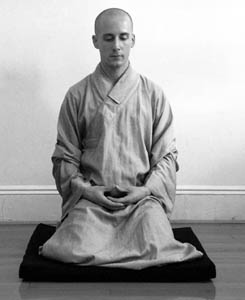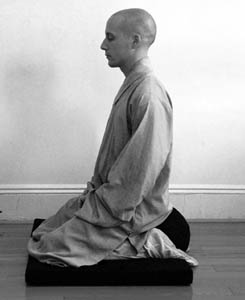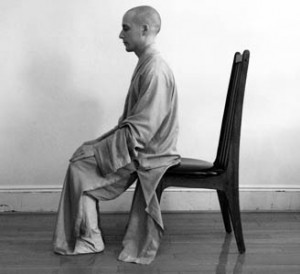How to Meditate 【转载】
The following is an excerpt from “Zuo Chan (Tso-Ch’an),” an article by Chan Master Sheng Yen, originally published in the October 1988 issue of the “Chung-Hwa Buddhist Journal.”
The Chinese term “zuo chan” (zazen) was in use among Buddhist practitioners even before the appearance of the Chan (Zen) School. Embedded in the term is the word “chan,” a derivative of the Indian “dhyana,” which is the yogic practice of attaining samadhi in meditation. Literally translated, “zuo chan” means “sitting chan” and has a comprehensive and specific meaning. The comprehensive meaning refers to any type of meditation practice based on the sitting posture. The specific meaning refers to the methods of practice that characterize Chan Buddhism.
FUNDAMENTALS OF ZUO CHAN
Zuo Chan (meditation) was practiced in China long before the appearance of Chan. The earlier masters practiced according to methods in the Hinayana sutras, which emphasized the techniques collectively known as samatha-vipasyana. Generally speaking, these were methods for achieving samadhi through three aspects: regulating one’s body, regulating one’s breathing, and regulating one’s mind.
REGULATING THE BODY BY SITTING
To regulate the body by sitting, one should observe the Vairocana Seven-Points of Sitting. This refers to the seven rules of correct sitting posture. Each of these criteria has been used unchanged since ancient days.
POINT ONE: THE LEGS
Sit on the floor with legs crossed either in the Full Lotus or Half Lotus position. To make the Full Lotus, put the right foot on the left thigh, then put the left foot crossed over the right leg onto the right thigh. To reverse the direction of the feet is also acceptable.
To take the Half Lotus position requires that one foot be crossed over onto the thigh of the other. The other foot will be placed underneath the raised leg.
The Full or Half Lotus are the correct seated meditation postures according to the seven-point method. However, we will describe some alternative postures since for various reasons, people may not always be able to sit in the Full or Half Lotus.
A position, called the Burmese position, is similar to the Half Lotus, except that one foot is crossed over onto the calf, rather than the thigh, of the other leg.
Another position consists in kneeling. In this position, kneel with the legs together. The upper part of the body can be erect from knee to head, or the buttocks can be resting on the heels.
If physical problems prevent sitting in any of the above positions, then sitting on a chair is possible, but as a last resort to the above postures.
The positions above are given in the preferred order, the Full Lotus being the most stable, and most conductive to good results. Sitting cross-legged is most conducive to sitting long periods with effective concentration. The position one can take depends on factors such as physical condition, health, and age. However, one should use the position in which prolonged sitting (at least twenty minutes or more) is feasible and reasonably comfortable. however, do not use a position that requires little, or the least effort, because without significant effort, no good results can be attained.
If sitting on the floor, sit on a Japanese-style zafu (round meditation cushion) or an improvised cushion, several inches thick. This is partly for comfort, but also because it is easier to maintain an erect spine if the buttocks are slightly raised. Place a larger, square pad, such as a Japanese zabuton, underneath the cushion. Sit with the buttocks towards the front half of the cushion, the knees resting on the pad.
POINT TWO: THE SPINE
The spine must be upright. This does not mean to thrust your chest forward, but rather to make sure that your lower back is erect, not just slumped. The chin must be tucked in a little bit. Both of these points together cause you to naturally maintain a very upright spine. An upright spine also means a vertical spine, leaning neither forward or backward, right or left.
POINT THREE: THE HANDS
The hands form a so-called Dharma Realm Samadhi Mudra. The open right palm is underneath, and the open left palm rests in the right palm. The thumbs lightly touch to form a closed circle or oval. The hands are placed in front of the abdomen, and rest on the legs.
POINT FOUR: THE SHOULDERS
Let the shoulders be relaxed, the arms hanging loosely. There should be no sense of your shoulders, arms, or hands. If you have any sensation of these parts, there is probably tension in those areas.
POINT FIVE: THE TONGUE
The tip of the tongue should be lightly touching the roof of the mouth just behind the front teeth. If you have too much saliva, you can let go of this connection. If you have no saliva at all, you can apply greater pressure with the tip of the tongue.
POINT SIX: THE MOUTH
The mouth must always be closed. At all times, breath through the nose, not through the mouth
POINT SEVEN: THE EYES
The eyes should be slightly open and gazing downward at a forty-five degree angle. Reset the eyes in that direction, trying not to stare at anything. Closing the eyes may cause drowsiness, or visual illusions. However, if your eyes feel very tired you can close them for a short while.
REGULATING THE BODY BY WALKING
Regulating the body by walking consists of slow walking and fast walking. Walking meditation is especially useful for a change of pace when engaged in prolonged sitting, such as on personal or group retreats. Periods of walking can be taken between sittings.
In slow walking, the upper body should be in the same posture as in sitting, the difference being in the position of the hands. The left palm should lightly enclose the right hand, which is a loosely form fist. The hands should be held in front of, but not touching, the abdomen. The forearms should be parallel to the ground. The attention should be on bottom of the feet as you walk very slowly, the steps being short, about the length of one’s foot. If walking in an enclosed space, walk in a clockwise direction.
Fast walking is done by walking rapidly without actually running. The main difference in posture from slow walking is that the arms are now dropped to the sides, swinging forwards and backwards, as in natural walking. Take short fast steps, keeping the attention on the feet.
SUPPLEMENTARY EXERCISE
Sitting and walking are the two basic methods of regulating your body. There is a supplementary aspect which is to exercise for a short period after sitting, even if you only do one sitting per day. The form of exercise is a matter of individual choice, but it should be moderate, such as Tai Chi or Yoga.
REGULATING OF THE BREATH
Regulation of the breath is very simple. It’s just your natural breathing. Do not try to control your breathing. The break is used as a way to focus, to concentrate the minds. In other words, we bring the two things – regulating the breathing and regulating the mind together.
REGULATING THE MIND BY COUNTING THE BREATH
The basic method of regulating the mind is to count one’s breath in a repeating cycle of ten breaths. The basic idea is that by concentration on the simple technique of counting, this leaves the mind with less opportunity for wandering thoughts. Starting with one, mentally (not vocally) count each exhalation until you reach ten, keeping the attention on the counting. After reaching ten, starting the cycle over again, starting with one. Do not count during the inhalation, but just keep the mind on the intake of air through the nose. If wandering thoughts occur while counting, just ignore them and continue counting. If wandering thoughts cause you to lose count, or go beyond ten, as soon as you become aware of it, start all over again at one.
REGULATING THE MIND BY WATCHING THE BREATH
If your wandering thoughts are minimal, and you can maintain the count without losing it, you can drop counting and just observe your breath going in and out. Keep your intention at the tip of your nose. If, without any conscious effort, your breathing naturally descends to the lower abdomen, allow your attention to follow your breathing there. Do not try to control the tempo of your breathing: just watch and follow it naturally. A less strenuous method, also conducive to the peaceful mind, is to just keep your attention on the breath going in and out of your nostrils. Again, ignore wandering thoughts. When you become aware that you have been interrupted by thoughts, just return to the method.
REGULATING THE MIND BY WATCHING THE DAN TIAN
A third method of regulating the mind is to focus the attention on the dan tian, which is a point located below the navel. the dan tian is not an organ, but a center of psychic energy similar to the Indian chakras. This method is best employed when your breathing has naturally descend to the abdomen. The technique consists simply in mentally following the movements of the dan tian as the abdomen moves in and out as a natural consequence of breathing. This method is more energetic than the methods of breath counting or following, and should be used only after gaining some proficiency in those methods. In any case, the method should not be forced.
GENERAL INSTRUCTIONS
Although the methods of meditation given above are simple and straightforward, it is best to practice them under the guidance of a teacher. Without a teacher, a meditator will not be able to correct beginner’s mistakes, which if uncorrected, could lead to problems or lack of useful results.
In practicing meditation, it is important that body and mind be relaxed. If one is physically or mentally tense, trying to meditate can be counter-productive. Sometimes certain feelings or phenomena arise while meditating. If you are relaxed, whatever symptoms arise are usually good. It can be pain, soreness, itchiness, warmth or coolness, these can all be beneficial. But in the context of tenseness, these same symptoms may indicate obstacles.
For example, despite being relaxed when meditating, you can sense pain in some parts of the body. Frequently, this may mean that tensions you were not aware of are benefiting from the circulation of blood and energy induced by meditation. A problem originally existing may be alleviated. On the other hand, if you are very tense while meditating and feel pain, the reason may be that the tension is causing the pain. So the same symptom of pain can indicate two different causes: an original problem getting better, or a new problem being created.
A safe and recommended approach is to initially limit sitting to half an hour, or two half-hour segments, in as relaxed a manner as possible. This refers not only to your inner, but also your outer environment. For beginners, if the mind is burdened with outside concerns, it may be better to relieve some of these burdens before sitting. For this reason, it is best to sit early in the morning, before dealing with the problems of the day. Sitting times may be increased with experience. But people who meditate for extended periods may become so engrossed in their effort that they may not recognize their tensions. This frequently exists because their minds are preoccupied with getting results. So to work hard on meditation means to just put your mind on meditation itself. If you can just do that, there is no reason for tension to arise. On the contrary, deeper relaxation, and calming of the body and mind should result.






